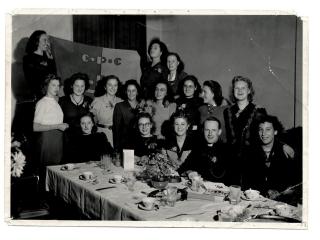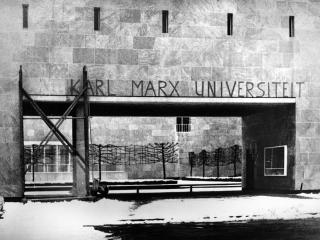Fons Pennartz’ inspiring conversations with Cobbenhagen
There are few alumni left who were taught by Martinus Cobbenhagen, the founding father of Tilburg University. The 94-year-old Alphons Pennartz (nicknamed Fons) is one of them. A nostalgic double portrait with his soon-to-retire son Peter, also an alumnus of Tilburg University in Economics.
Born in 1926 in Roermond, Fons comes from a big family with nine children: seven sisters and a younger brother Paul. I met Fons at his summer house in Bavel, where it's easier to maintain social distancing than in his apartment in Breda. With him was his wife, who he got to know during his student days (currently celebrating 65 years of marriage!), and his soon-to-retire son Peter, also an alumnus of Tilburg University in Economics, who resides in "the most beautiful town in the country."
It was just after the war. For Fons, the time had come to go to college. After a good discussion with his father, he chose Economics at the then Katholieke Economische Handelshoogeschool (Catholic College of Economics) in Tilburg. Before he enrolled, Fons's father travelled by truck from Roermond to Tilburg – his hat didn't survive the trip. He was seeking advice from no one less than Professor Martinus Cobbenhagen. That's right, the big man of the university and Rector Magnificus from 1945-46. Both men hailed from the village of Gulpen in Limburg, and that created a bond. Cobbenhagen, the son of a candle manufacturer, and father Pennartz, an organist and choir conductor in Roermond. After this preparatory conversation, son Fons headed westward to Tilburg in 1945. 'Send him along'.
Not a Party Animal
Fons rented a room from a landlady on a side street off the J.P. Coenstraat in the Armhoefse Akkers district, a short distance from the college, which at the time was situated on the Bosscheweg, the part that is now Tivolistraat (where the garden of Interpolis is). Towards the end of his study, he met fellow student Chris Smeekes, later the boss of Stichting Etherreclame (Foundation for Broadcasting Advertising, STER, with Loekie the Lion), who was to take over his room in Tilburg (Smeekes, now also 94, is also living, and Fons was looking for him and found him recently).
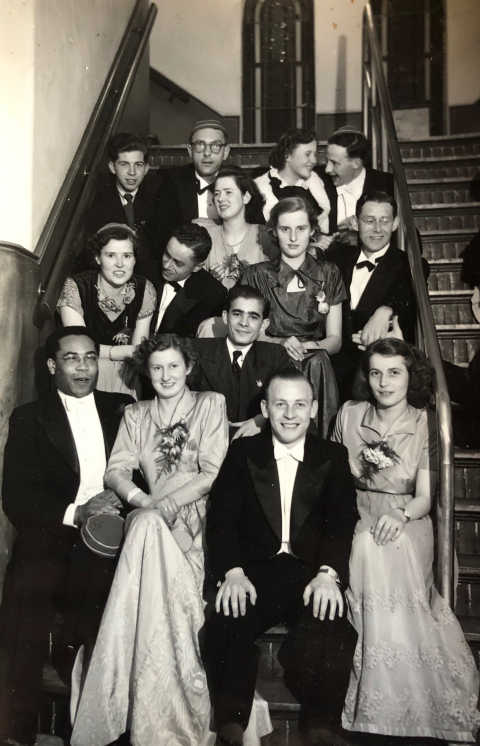
No, the landlady didn't run a tight ship. There weren't any strict rules. They could do what they liked. But they also weren't a wild bunch. Not party animals who spend all their time living it up as students. Yes, annual celebrations and the like, Fons didn't miss out on those, neatly dressed in tails and a bow tie. From 1948, his girlfriend, Ria Roijers of Tilburg, went with him. He met her while playing table tennis. Fons used to occasionally visit Ria at home in Tilburg, but she never came to his room. It all remained "chaste and proper.” The couple married in 1955, five years after he graduated. They rented a top-floor flat in Vught, in Villa Peterhof. So anno 2020 they celebrated their 65th wedding anniversary. Three cheers!
Photo: Dies Natalis celebrations 1949, for students and guests. Couple middle right: Fons with his girlfriend Ria. First row left, Ben Leito (†), the first Black governor of the Dutch Antilles from 1970 to 1983, who died in 1996 at the age of 73. First row right, the now deceased Geert van Brunschot (†).
Initiation
Fons became a member of the student fraternity Sint Olof, as did nearly everyone at the time, but was not a fanatic member. He went his own way. The Olof frat house was an old mansion on the Sint Josephstraat. In those days there were a few female students, but not many. Around 30. They had their own sorority. Fons can still remember the Olof president and "eternal student” Han Loevendie (the later secretary of the board of governors of the college), and a certain Norbert Schmelzer, also a member of the Olof frat council. “That's right, who is known for the Night of Schmelzer in 1966 when the government… uh, what was the prime minister's name again?… oh right, Cals… when the government collapsed.”
Initiation was a must, but not a lot of fun. “It was tough, lasted for weeks, and you had to walk through town with green hat on. You were humiliated and had to crawl on the ground under the watchful eyes of drunken initiators. No, that was not for me. Well, you couldn't get out of it. But once and a while I snuck off.”
1945
The war had left substantial scars on the student life of Tilburg. Many students went underground, were arrested, or were deported. Ultimately, 22 students died during bombing raids, in the resistance, in concentration camps, or as a result of forced labor.[1]
After the war, about 236 first-year students, including Fons, started their program in Commerce. That year, the college had a total of 617 students. In 1950, Fons’s graduating year, the total rose to 780, three quarters of whom came from the provinces of Noord-Brabant and Limburg.[2] In comparison: today the counter is at about 19,000 student enrollments. And since the founding, around 78,000 alumni have been sent into the world.[3]
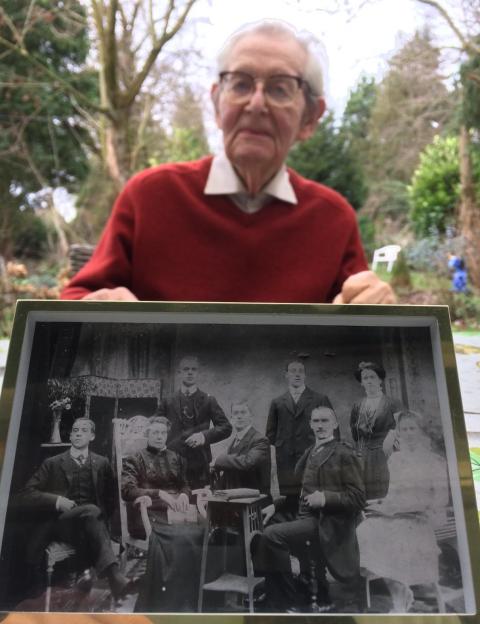
Photo: At his summer house in Bavel, Fons Pennartz shows us a family photograph with his parents and grandparents.
Fons
Professor Cobbenhagen was an inspiring, amiable man
'Given' his HBS diploma
After 1945, the then Katholieke Economische Handelshoogeschool (the name was changed in 1936) expected a large increase in students who had left the war, had been in labor camps or had gone into hiding. Fons and a fellow student wanted to be ahead of this influx and registered for the propaedeutic exam early on. But after a 'good conversation', Cobbenhagen said, according to Fons, that it was far too early to pass such an exam properly. But four months later he hit the bullseye and could then proceed to the candidate level, as it was then called. At the time the program was divided into three parts: propaedeutic (1 year), candidate level (2 years), and doctoral level (2 years).
Fons
After a good interview I could proceed to the candidate level
Earlier in the war, Fons had also just been "given" his HBS diploma. In his own words: “The HBS diploma was handed to me.” The next question was: what to do now? Becoming a priest was an important option at the time, especially in the southern Netherlands and in Catholic families. But Fons wasn't interested. His desire was to go to college. And so it was.
Lectures with Men of the First Hour
Right from the beginning Fons went to lectures given almost only by professors of the first hour. Hendricus A. Kaag (Money, Credit and Banking Systems, Political Economy), Thomas J. A.J Goossens (History of Economics), Frans N.M. Weve (Ethics, Logic, Sociology, and Psychology), Emilius G.J. Gimbrère (Civil Law and Commercial Law), Jan E. de Quay (Corporate Organization), and a young lecturer Jan J.J. Dalmulder (Statistics), to name but a few.
But he vividly remembers the lively lectures of Martinus Cobbenhagen[4], who taught General Studies and History of Economics. In every year of his program, he occupied a desk in Professor Cobbenhagen's lectures. “A pleasant, inspiring man, with a forceful but amiable character. It was always standing room only at his Economics lectures on the Bosscheweg.”
Fons
Cobbenhagen stuck to his belief in Creation
Cobbenhagen and Creation
Cobbenhagen often invited students to visit him at home, in the corner house on the Korvelseweg. During those evenings we had “good discussions about the meaning of life, how you should live your life, or Creation and the origins of human life.” Cobbenhagen was critical of the theory of evolution and stuck to his belief in the story of Creation. Fons had different ideas. And so they held various "philosophical discussions" about the origins of human life. The theory of evolution clashed with the story of Creation, with Fons taking the standpoint of the former. “However,” Fons concedes, “Cobbenhagen didn't just dismiss you for that. He respected different points of view when it came to faith and Creation.” And Fons gradually moved away from the beliefs that he had received when he was growing up.
Cobbenhagen organized exams at his home. And he wasn't the only one. Under the Dominican priest Weve, you went to the monastery on the Korvelplein, and under Kaag, to his house on the Wilhelmina Park. Only Gimbrère had you write exams at the college.
A Piece of Cake
It is 1950. Fons took his oral doctoral exam in four subjects, with Cobbenhagen, Gimbrère, Weve and Geertman. The latter came from Eindhoven and taught the course Business Organization . Fons: "There is another nice anecdote about that exam with Geertman. It was about the car industry in the US. Apparently Geertman had just read a book about it and had taken it back to the library with the necessary underlining. Fons borrowed that work the day before his exam, which turned out to be a bull's eye, as he scored with the explanation of the Conveyer system, a new kind of industrial conveyor belt. "Well, I'm impressed," said professor Geertman.
Exam in the pocket. Fons went through his economics studies successfully and smoothly in the nominal time. It was 'a piece of cake', he said.
After Graduation up to the Business World
After graduation Fons works for various businesses. His first job is at Smoorenburg confectioners in Amsterdam ("a learning experience"). He then worked as an economist for a sand transport company, which built the first industrial estates and was also involved in raising the dikes after the flood disaster of 1953, and as a financial man at the Backer & Rueb machine factory in Breda. After his fiftieth birthday, Fons landed at the semi-public sector organization NEHEM in Den Bosch, which stimulates businesses, such as foundries, tanneries and galvanizing companies, at the time unhealthy factories to work at, to invest in cleaner production processes (“important and meaningful”).
The retirement fund is losing a lot of money on this couple, because, along with his spouse, he's been enjoying his retirement benefits for around 30 years, while in the company of his four sons and only daughter, eleven grandchildren, and three great-grandchildren.
Brother Paul
His younger brother Paul Pennartz (1935) – there's an eight year gap – also obtained a degree in Tilburg. Sociology. He graduated in 1960. What's more, he was also supervised by the Tilburg professor Ruud de Moor. Afterwards he became a professor at Wageningen University and published on phenomenology, semiotics, environmental studies, architecture and urban planning. He died in 2011 at the age of 75.
Son Peter
Peter Pennartz (1956) followed in his father's footsteps and also studied Economics at the Catholic College of Tilburg, as it was then called. Peter: “I always found the lectures of Professor Giel Plattel really stimulating – philosophy, logic, and ethics.”
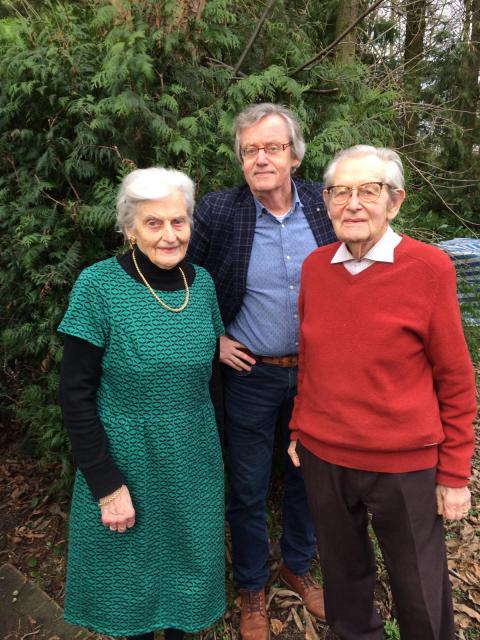
In addition to doing a little studying, Peter also moved in the critical underground circles of the college, drawing cartoons for the rebellious "independent" student newspaper Kappataal of the School of Economics. The stencil machine – who still knows what that is? – made overtime in the basement under Building A (currently C), where the beadle now has his office. He can again smell the noxious fumes from the "text burner," as it were, when he thinks back to those days (this technology has been replaced by photocopying and laser printing).
Photo left to right: Ria Roijers-Pennartz (94), Peter Pennartz (64), and Fons Pennartz (94)
Peter
I always found Giel Plattel's lectures stimulating
From these basements, student counterculture was planned and directed ("revolution, hahaha") against the bourgeois economy, professors were knocked off their pedestals with polemics, and classic theories of economics were torpedoed. It was also the era when there was a controversy about adding the subject Political Economy to the curriculum. Peter went wild drawing comic caricatures of Henk Argeloos and Bob van Zwendelen. Not just for Kappataal, but in later years also for LWEO materials distributed to economics teachers in high schools and the LWEO website.
Peter: “Henk Argeloos was a kind of know-it-all TinTin, with an arched right eyebrow, who stares the reader right in the eye and gives the impression that what he says is really true (which it is). Shaking his finger to convince the most stoical readers that he is barking up the right tree, and that he also really believes that. The figure of Bob van Zwendelen is, besides being Bob van Zwendelen, also a businessman, tax advisor, bookkeeper, and accountant.”
Peter
The stenciling machine for the student newspaper Kappataal made overtime in the 1970s
Corporate Social Responsibility
After graduation Peter worked for almost 25 years for an organization in the field of international labor law, where he was responsible for giving workshops and seminars in Europe, Asia, Africa, and Latin America in corporate social responsibility. Peter: “Briefly put: bringing together people from all parts of the world – from unions and human rights organizations to businesses – to see how multinationals like Nike, H&M, Shell, and Adidas run their operations in developing countries. And whether they obey international labor laws and make sure that workers are paid a living wage, that working conditions are safe, and that the environment is protected."
International Business Management
At a certain point Peter decided to switch over to “one of the most dynamic, innovative, autarchic, anarchic jobs in this world: teaching.” He joined the staff of the International Business Management School of Avans in Breda. “An international school where everyone speaks English is really useful. Students can always claim that, if they don't pass, it's not their fault.”
In this way, Peter sets his experience protecting the interests of human rights and workers' rights up against the profit-motivated business models of the big multinationals, and brings these ideas in the spotlight for international students. "That means that future managers are also confronted with the campaigns pursued by human rights organizations, unions, and organizations such as Stichting Onderzoek Multinationale Ondernemingen (Foundation for Research into Multinational Corporations, SOMO). So that they can develop a wider view of things than they get from marketing and management classes alone."
Peter
Education is one of the most dynamic, innovative, autarchic, anarchic jobs in this world
The globetrotter toured the world from his home base in the metropolis of Tilburg, in the heart of Europe. In the meantime he has written a book, The European Union and the South (Jan van Arkel/International Books), obviously filled with caricatures of various types, and later co-authored with colleagues in his teacher training program run by Fontys in Tilburg a book entitled Lesgeven over duurzame ontwikkeling (Teaching Sustainable Development) (Garant Uitgevers). He goes on to say something about macro-economics, corporate social responsibility, and business ethics, because early retirement is beckoning in the near future.
And he regularly accompanies mum and dad on visits to their summer house outside Breda.
On 12 November 2022, Fons Pennartz passed away. He was 96 years old.
Voetnoten (in Dutch)
[1] See www.monumentvoordevrijheid.nl/ In 2017 a monument to honor the fallen in World War II was revealed in the Cobbenhagen building, which also has a digital form.
[2] Hans Bornewasser: Katholieke Hogeschool Tilburg, part 1. 1927-1954, Ambo 1978
[3] See facts and figures Tilburg University website www.tilburguniversity.edu/about
[4] Martinus Joseph Hubertus Cobbenhagen (1893-1954) was rector magnificus of the RK Handelshoogeschool during the years 1932-33, 1937-38 en 1945-46. He is considered as the founding father of the university, although he was not the founder and first rector (that was Goossens) because of his idea of combining economics and ethics, the importance of the philosophical aspects and his vision on education (with philosophy as mandatory course), his attention for student life and alumni, as well as his administative efforts.
Also in Tilburg University Magazine
Date of publication: 29 January 2021

